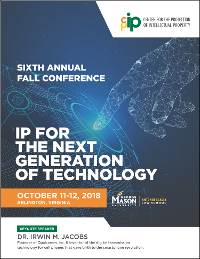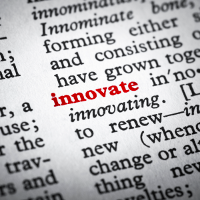The following post comes from David Ward, a rising 2L at Scalia Law and a Research Assistant at CPIP.
 By David Ward
By David Ward
“Casual metaphors can have dangerous consequences.” CPIP Senior Fellow for Innovation Policy Jonathan Barnett’s new paper, The ‘License as Tax’ Fallacy, seeks to undo what he considers to be a dangerous, casual metaphor, namely, that intellectual property is a “state-granted monopoly” and therefore licensing is a “monopolistic tax” on consumers. Instead, Prof. Barnett explains that licensing is a tool that creates value for consumers and producers alike.
Historical Roller Coaster
This “IP = monopoly” metaphor has seen a bit of a jurisprudential roller coaster over the past century. Its origin is tied to monopoly-busting antitrust cases, as one might expect, starting around the end of the New Deal era of the late 1930s. Many of the battles were over the practice of “tying” patented products to other products in bundles. For those unaware, in antitrust, “tying” is essentially an arrangement that requires the buyer of one product to buy something else as well, and this often can be viewed as anticompetitive. These patent-tying cases led to the Supreme Court making a hard-and-fast rule in the 1962 case United States v. Loews. The Loews case effectively outlawed tying arrangements in patent licenses as anticompetitive, without having to prove any actual anticompetitive consequences.
This pivotal case cemented a metaphorical assumption that intellectual property is a state-granted monopoly. Further evolution of this mindset led to an effective halt of many licensing transaction options that were once available to sellers in the IP market. Prof. Barnett points out that this ended up harming consumers rather than protecting them. Sellers wishing to license their intellectual property, but restrict how it was used, would often not sell rather than risk getting hit with an antitrust lawsuit under the not-so-IP-friendly antitrust rules in the courts. And those that did license charged higher prices since they could not enforce value-saving restrictions.
The roller coaster didn’t stop there, though, as the late 1970s Supreme Court moved away from the stifling hard-and-fast rules in two new decisions, U.S. Steel and Sylvania. Instead of assuming that many IP license provisions (such as tying) were anticompetitive on their face, the Court began requiring proof that the provision in question was actually anticompetitive—just as in nearly every other antitrust case. This more license-friendly trend toward requiring proof of anticompetitive IP practices culminated in the 1995 U.S. Department of Justice Antitrust Guidelines for Licensing of Intellectual Property, which concluded that antitrust challenges to licensing transactions have to provide evidence of harm to the market. The bright line licensing rules of the past were effectively gone.
Recent Years: The Lexmark Case
But the coaster did not stop there either, as the mid-2000s and recent years have seen a resurgence of more hard-and-fast IP licensing rules. A great example of the resurgence of these rules is the 2017 case Impression Products v. Lexmark International, which involved the oft-dreaded purchasing of printer ink cartridges. Lexmark sold two types of ink cartridges: expensive ones that users could refill, and cheap ones that users were not allowed to refill. The cheap cartridges included a licensing provision that did not allow users to refill the cartridge in exchange for the lower cost. Impression Products, however, bought the empty, cheap cartridges from third party resellers, refilled them, and sold them for a profit, despite being aware of this license provision that prohibited refilling them.
Impression Products leaned on what is called the “patent exhaustion doctrine” to win the case. This doctrine can end a patent owner’s right to control a product once it has been sold, much in the same way that used bookstores don’t have to get a copyright license to sell a used book. However, the Court overturned a long-standing, fact-specific rule that required examining the market impact of such provisions in patent reseller cases. Instead, it adopted a hard-line rule that does not allow patent owners to enforce their licensing provisions on products that have already been sold, without any analysis on the market impact.
This illustrative example of a return to the hard-and-fast rules of the past is exactly what Prof. Barnett warns against. In the instance of printer ink cartridges, companies now provide fewer options at a higher price since they can’t enforce a provision that allows them to offer a lower-value, lower-cost alternative. But the anticompetitive implications of the Lexmark decision can have far-reaching effects on intellectual property as a whole; hard-line rules that prohibit the enforcement of licensing provisions without any analysis of the impact on the market creates less choice and higher cost for consumers. This, of course, is exactly the opposite of the aim of the antitrust laws.
The Need for Evidence
It’s important to note that Prof. Barnett acknowledges that intellectual property can cause anticompetitive practices that harm consumers. But he contends that there needs to be evidence showing that specific intellectual property licenses have anti-consumer implications, as there is in most other antitrust cases. The theoretical fear of intellectual property licensing clogging up markets with exorbitant rates (the “licensing tax”), if it has any merit, should be backed up by evidence.
A great case study for this issue comes from the smartphone market. In the smartphone industry, there are countless “standards” for wireless signals and products, such as 4G, that are required for our many devices to interact in a uniform manner. The inventors of these standards have what are called “standard essential patents,” or SEPs. There is a great fear that these patents, being quite literally essential to smartphone manufacturers, will allow their owners to exploit markets and charge anticompetitive pricing.
The great mystery is that, despite this, there isn’t evidence that this hypothetical scenario exists. Prof. Barnett examines three decades of market performance in this industry and shows that SEP licensing royalties account for a modest three to five percent of global handset revenues. This is in stark contrast to the hypothetical models that anticipated double-digit royalty percentages because of the “IP licensing tax.”
Prof. Barnett attributes this disconnect to several factors, but most importantly he points to the fact that regulators, legislatures, and judges should be focusing on real-world impacts from actual evidence and data when contemplating new rules and regulations.
The Real-World Benefits of Licensing
Although some assume that licensing will create anticompetitive environments, there is ample evidence to show that licensing enables competition and diverse markets. Prof. Barnett uses several real-life models to demonstrate this point.
The first model is the “Hub-and-Spoke” structure, where several smaller intellectual property owners license their IP to large companies with commercial power and reach. The best example of this is in the movie business, where outside production companies license their works to large studios. Each party specializes in something different, and a mutually beneficial relationship occurs. If IP licensing agreements cannot be enforced, such as in Impression Products, then content production would consolidate vertically to larger in-house organizations as firms look to protect their creative property. Essentially, not allowing licensing enforcement in this setting actually consolidates the market, rather than diversifying it.
The second model is the reverse of this, where large, usually research-based, firms license their innovations to many different commercialized entities. A prime example of this is Qualcomm, which licenses its wireless communications technology to many smartphone device manufacturers. Rather than hoard their technologies, these firms want to use licensing mechanisms to reach as many users as possible; more users equal more royalties, so there is an incentive to license to many manufacturers at affordable rates. This creates a positive feedback for more R&D and innovation, rather than an “IP = monopoly” hypothetical scenario where innovators gouge licensees.
The third model involves hybrid pooling and anti-licenses. Patent pools and other aggregate entities like music performing rights organizations create ecosystems of mutual benefit to help navigate dense “thickets” of intellectual property. For instance, rather than needing to get a license for every song played at a music venue, the venue can simply get one “blanket license” from a performing rights organization that licenses thousands of songs from the organization’s musicians at once. And somewhat more surprising is the complete lack of licenses at all. Many IT companies give away licenses for free to build a consumer base of users as an early adoption strategy. Contrary to the license-as-tax view, there is no necessary basis to even assume licenses are always used or even the best option for an owner.
Licenses Aren’t Taxes
The theoretical boogeyman of IP licensing creating monopolistic “taxes” has not held up to the intense scrutiny of the evidence, Prof. Barnett concludes. Any restrictions of IP licensing should be based in evidence and not be a knee-jerk reaction to hypothetical scenarios that have not come to pass, such as in the smartphone industry. There is far more evidence to show that licensing creates value for the market than there is evidence to show it “taxes” the market. And thus, this dangerous, common metaphor of “IP = monopoly” should be put to rest.
 By
By  Earlier this year, CPIP’s Adam Mossoff and Kevin Madigan
Earlier this year, CPIP’s Adam Mossoff and Kevin Madigan  By
By  A group of judges, former judges and government officials, law professors and economists with expertise in antitrust law and patent law
A group of judges, former judges and government officials, law professors and economists with expertise in antitrust law and patent law  CPIP has released a new policy brief,
CPIP has released a new policy brief, 